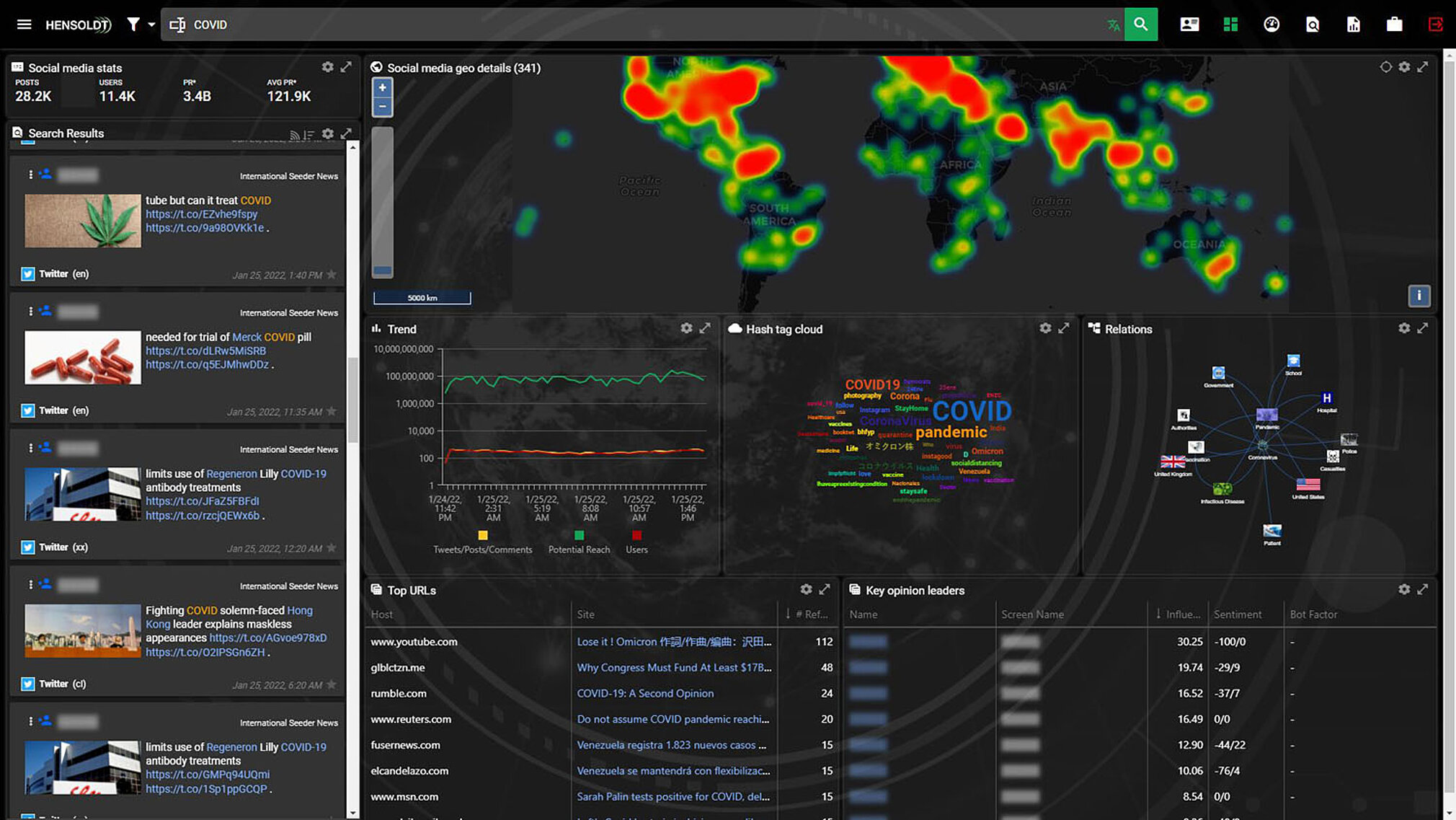OSINT – Open Source Intelligence
Empowering users with open-source data
We are now surrounded by a wealth of information, and the ability to collect open-source data from multiple sources and turn it into useful intelligence is vital for many sectors. HENSOLDT Analytics is at the forefront of developing market-leading OSINT solutions for its customers, and continues to invest in this disruptive capability.
February 23, 2022
info@hensoldt.net
CATEGORIES:
Innovation,
HENSOLDT Analytics (external website)
OSINT – Not only a matter of defence
The open-source intelligence (OSINT) market has been revolutionised over the past two decades, as the power of using this type of information to increase situational awareness has gained significant attention.
While the defence and security sectors were once the mainstay of OSINT, applications including law enforcement, politics, natural disaster management, critical infrastructure protection, business intelligence and public health surveys are also gaining popularity.
OSINT can include many different types of data from multiple sources, such as TV, radio, print, YouTube, social media, websites, RSS feeds and other electronic documents, often incorporating several thousand sources in real time.
Take the rise of hybrid warfare, and the disinformation associated with this. One of the primary goals of these hostile actors is to weaponise information to destabilise whoever they are waging hybrid warfare against.
“This type of destabilisation can take several forms, for example it can create an environment of polarisation, which could lead to social unrest,” explains Anne-Lynn Dudenhöfer, OSINT analyst at HENSOLDT Analytics. As she continues:
“One of the very common forms of hybrid warfare is spreading disinformation and fake news. All of this leads to the weakening of social and government structures, which at a state level is vital to manage and control.”
Anne-Lynn Dudenhöfer
OSINT analyst at HENSOLDT Analytics
What OSINT analytics can do is process raw, noisy and unstructured open-source data, providing intelligence solutions that tap into big data analytics, video analytics, text analytics, and social media analysis.

The beginning of HENSOLDT Analytics
As the demand for OSINT has increased – especially over the past two years – this landscape has inevitably become a more competitive one. As such, in January 2021 HENSOLDT sought to expand its OSINT offerings, acquiring a speech recognition and language processing specialized company, and from that HENSOLDT Analytics was born.
“We see – and this will increase in the future – that open-source intelligence will be combined more and more with a lot of other intelligence technologies, such as geospatial intelligence, measurement and signature intelligence, human intelligence, and signals intelligence, just to name a few.”
Ben Spaeh, Managing Director of HENSOLDT Analytics
Combining the acquired specialities with HENSOLDT’s investments in areas such as artificial intelligence (AI) and big data analytics, the business division offers an integrated cross-media, cross-lingual OSINT platform and visualisation tool for professionals.
It is essentially a platform that analysts and decision-makers in their respective sectors can use to monitor big data and key information from multiple open sources across multiple languages. The Media Mining Tool platform is a full end-to-end OSINT solution that automatically records and harvests image and text data, including speech from TV, radio, and videos transcribed in more than 32 languages.
Data is then automatically indexed, translated and enriched with information, such as speaker ID, named entities, topics, sentiment, bot detection and face and object recognition using computer vision algorithms. Importantly for analysts, this data is stored on servers and can be accessed and retrieved immediately as required.
The data is then transformed into visualisations for analysis based on the analyst’s interests, such as global hotspots, trends in relationships, graphs, ontologies, and social media analytics. An entire workflow cycle is offered, so if collaborating as a team of analysts and decision-makers, the system can be used to inform the workflows to create actionable intelligence that is then signed off by a decision maker.
Furthermore, the system can filter the visualisations across all sources, according to the needs and interests of the analysts/decision-makers. Keywords – and named entities – can be searched for, and then filtered across, and dashboards can be created based on particular needs or interests. This filtering could be only for social media or just for TV, for example, or for a certain date and time or geographical region, as well as for bots and topics that are being talked about.
The future of OSINT
AI, machine learning and big data analytics are opening up new horizons for OSINT, and a combination of these technologies can create a powerful and valuable tool across all sorts of sectors. Sentiment analysis is another emerging requirement for OSINT. This allows for a real-time understanding of what is happening either in the world or in a certain country, or regarding a certain topic, not only traditional retrospective post-event analysis.
Hybrid warfare monitoring clearly falls under this, but so does sentiment monitoring in the lead up to elections.
Election rigging is now coming to the forefront of public attention, and an OSINT tool can be used to monitor and filter polarisation in sentiment regarding a particular topic in a certain geographical area, including accounts that are pushing certain narratives and where they're located. The user in this case could be election monitoring bodies, for example, not necessarily the political parties themselves.
“You can pretty much watch it unfold, which allows you to either counter it or act on it. Additionally, we can detect bot accounts on social media, which is enriching the OSINT platform’s abilities further,” Dudenhöfer says.
Based on an account’s posting behaviour and content, it is possible to analyse whether bot activity is increasing regarding a certain topic, or if it is trying to push certain narratives in the media. Flexibility is inherent in the Media Mining System, and this is what makes it so adaptable to all of these requirements.
This flexibility will also future-proof the tool for emerging requirements, providing an adaptable OSINT capability for whoever needs access to valuable open-source-based situational awareness.


